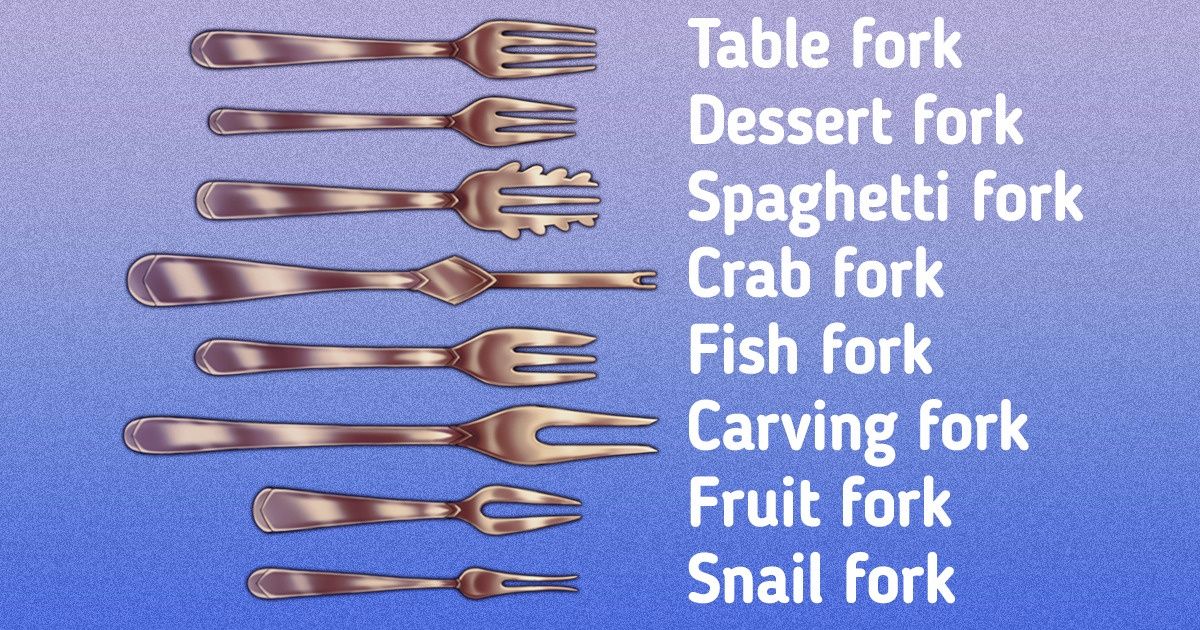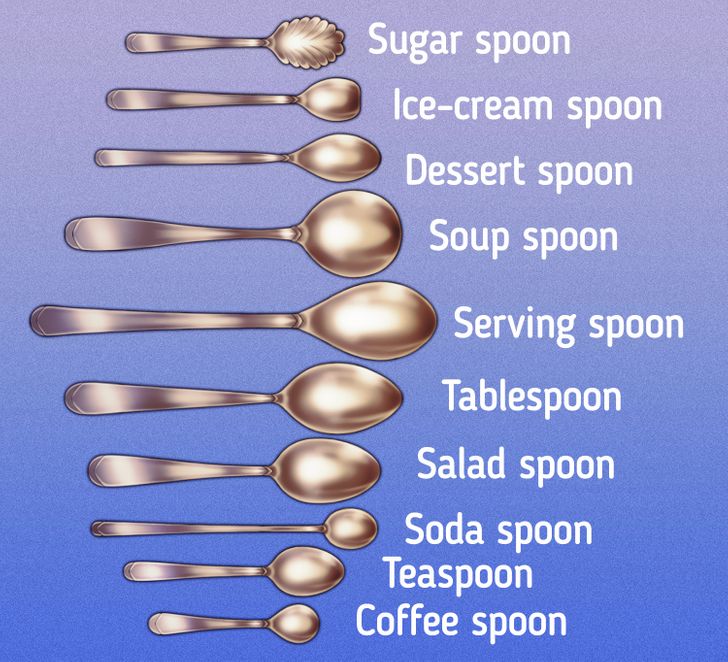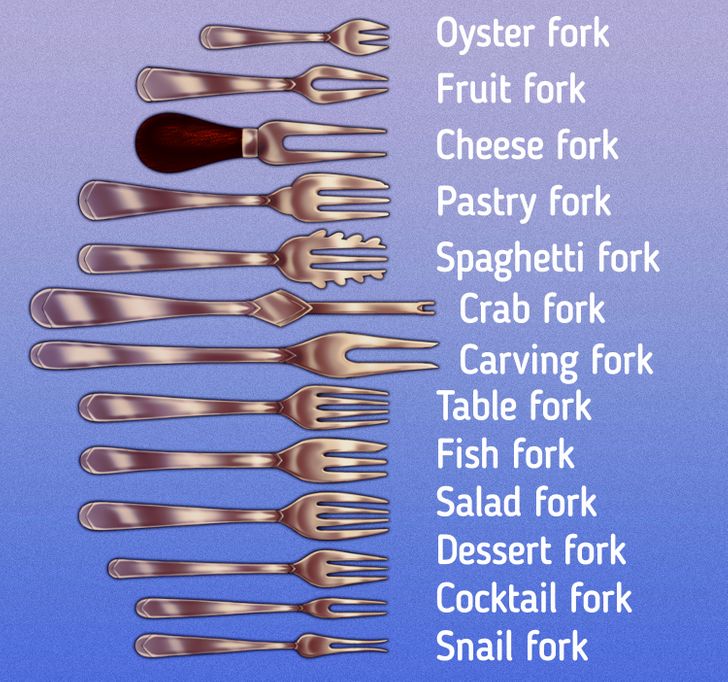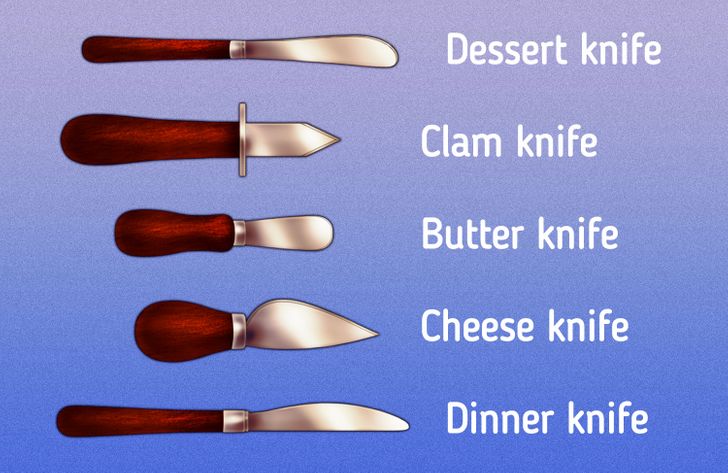Types of Cutlery, and How to Use Them

The majority of us use “standard” cutlery in everyday life. And surely, many of us never heard of an oyster fork, for example.
To avoid an awkward situation at a restaurant or a dinner party, use this guide from 5-Minute Crafts. You’ll find out how to not confuse a dessert fork with a fish fork, and which cutlery should be used for eating different dishes.
Types of spoons

- Tablespoon
It is quite large and elongated, and is used to eat main courses. It matches the size of a table fork and dinner knife. It is considered multi-purpose if you don’t have a large set of spoons. - Dessert spoon
Usually it’s smaller than a tablespoon and bigger than a teaspoon. Its tip is usually sharper, making it easy to separate pieces of a dessert or pie. - Teaspoon
It looks like a smaller version of a tablespoon and is also considered multi-purpose. It’s used for adding sugar to tea or coffee and stirring hot drinks. - Coffee spoon
It’s usually smaller than a teaspoon, and often has a shorter and thinner handle. It’s not intended for making coffee, but for serving along this drink. - Soup spoon
Its length is the same as the length of a tablespoon, but it has a rounder and deeper cup. This allows it to better retain liquid food inside. A smaller version of a soup spoon is a bouillon spoon that can be served with a light soup. - Sugar spoon
This is a small spoon with a wavy, petal-like cup. It’s used to take sugar from a sugar bowl. - Ice-cream spoon
It can be in small, medium, or large sizes, depending on the amount of ice-cream served and the size of a bowl. A characteristic feature of such a spoon is a flat cup, which makes it easy to get the remains of the dessert from the bottom of the bowl. - Soda spoon
It’s a spoon with a long handle. It’s often served with drinks in tall glasses. - Serving spoon
It looks like a bigger version of a tablespoon with a longer handle and a rounder cup. Most often it’s used at dinner parties, where different dishes are placed in the center of the table. With the help of such a spoon, guests can help themselves. - Salad spoon
It’s always paired with a salad fork for easy mixing and serving.
Types of forks

- Table fork
It’s a multi-purpose fork that you can find in any tableware set. Its size is similar to the one of a tablespoon. In most cases, it can be used for eating main courses, salads, and fish. However, in fine dining restaurants, it is likely to be replaced by a few specialist forks. - Dessert fork
It’s shorter than a table fork and a fruit fork, has a slightly thinner head with 3 prongs. It’s designed for eating desserts and various sweet dishes. - Fish fork
It looks like a regular table fork, except that the tine on the far left of the fork will be wider and thicker. It is used to separate flesh from bones. - Fruit fork
It’s a small fork with 2 prongs. It’s used to pick fruit slices. - Carving fork
It has a large handle and 2 long sharp prongs that can easily pierce and hold pieces of meat when carving. It’s served with a knife. - Salad fork
It’s usually slightly longer than a table fork. It also differs from it on its cutting edge, which can be used to cut dish ingredients. This fork is often paired with a salad spoon. - Cocktail fork
It’s a small 2-pronged utensil served with cocktails. It allows you to spear fruits, olives, and other small ingredients of drinks. - Crab fork
It has a small size, a very thin metal handle, and 2 small prongs at the end. These prongs are so sharp and small that they can easily reach into the crevices of shellfish to pull out all of the meat. It’s served with a variety of shellfish and crustaceans. - Snail fork
It looks like a cocktail fork. It has a small handle and 2 fine prongs. The fork design makes it easy to pull the snail out of the shell. It can also be served with canapés and other appetizers. - Oyster fork
This narrow 3-pronged fork will help you pull the oyster out of the shell easily. It can also be served with other types of seafood. - Pastry fork
It’s a small utensil with 3-4 prongs. The left prong of this fork is usually larger and flattened, and it has a beveled edge which helps it to work as a knife. It is used to separate small pieces from pastry. - Cheese fork
It usually has a thick wooden handle and 2 long, sharp prongs that can spear even very small pieces of cheese. These forks can also be used for slicing some soft types of cheese. - Spaghetti fork
This is a fork with 3 tines with special ridges. Thanks to them, it’s much easier to grip pasta and eat it. Despite the name, this fork is served with different types of long pasta, not just spaghetti.
Types of knives

- Dinner knife
It’s the longest knife in a cutlery set. It is multi-purpose and can be used both for cutting food and pushing it onto the fork. - Dessert knife
It is usually quite long, with a narrow blade that can be rounded or sharp. Sharpened knives are used for cutting hard desserts, while rounded knives are used to section off pieces of soft desserts. - Butter knife
It’s designed to apply soft foods such as butter, jam, or jelly on bread. It has blunt edges so you can’t cut anything with it. - Cheese knife
Such knives easily cut both hard and soft types of cheese thanks to their sharp, short, and wide blades. They can be different in shape and length. - Clam knife
The main purpose of this knife is to open hard shells of clams or oysters. Often, its blade has a beveled edge so that it is easier to insert it into the shell, which is usually closed tightly. Typically, these knives have short blades and handles.
Share This Article